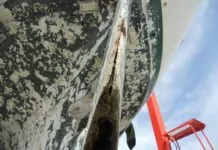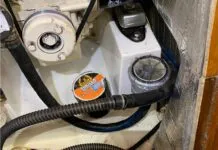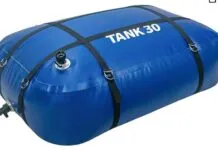Excerpted from The Art of Seamanship by Ralph Naranjo
We don’t practice the art of repairing sails at sea as much as we used to, thanks mostly to better materials and excellent engineering approaches. Nevertheless, those headed across an ocean or on a lengthy coastal voyage need a few sailmaker’s tools, including an awl, needle, and thread. Long-distance cruisers also need to understand a few key techniques, such as handling 3M Fast Cure 5200, which can fix many problems arising from chafe, sudden squalls, and poor reefing techniques.
Sail repairs at sea usually involve lessons in patience, ingenuity, and resourcefulness, and while woven Dacron is easiest to stitch back together, high-tech materials can also be hand stitched, glued, and put back into action. Tears often occur in areas other than seams, and patching may entail holding a covering pieces of material in place while stitching away without the advantages of a sail loft pit and sewing machine.
Use alcohol to clean the repair area, and once dry, coat the patch and sail with contact cement. The adhesive allows you to stick the patch in place and keep it from moving during the hand stitching. Double-sided sailmaker’s tape will do the same job for small patches, but contact cement has a more tenacious grip. Alternatively, you can use 3M Fast Cure 5200 to bond the patch in place. This approach harnesses the serious sticking quality of the polyurethane adhesive-sealant and lessens the need for multiple rows of hand stitching (in high-stress sail areas, e.g., around reef points, use the sealant and stitches). The cure time for regular 3M 5200 is a day or more, however, which limits its use but Fast Cure 5200 will speed up the process. Ideally, use scrap lengths of the same material your sails are made from to execute the repair.
Your sail repair ditty bag should contain an array of sail needles and palms for lefties as well as right-handers, and several awls or punches to make penetrating thick, multilayer sail corners and reef points a little easier. You’ll also need thread and twine of different deniers and strengths to use along the edges of nylon webbing, along with sticky-back nylon cloth for spinnaker repair. Choose other tools of the trade that fit both your budget and tool locker. For example, I’ve always carried a hand-cranked sewing machine for long-term cruising, as much for repairing awnings and sail covers as for sails. While not a necessity, it comes in handy more often than you might think.
To learn more about sails, sail handling and preparing for inevitable repairs while cruising, purchase Ralph Naranjo’s The Art of Seamanship from Practical Sailor.






































